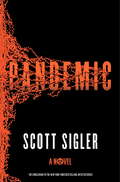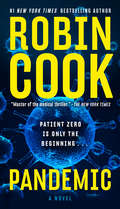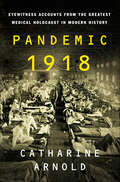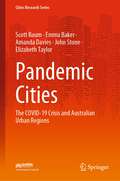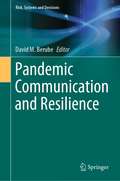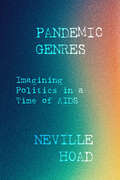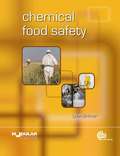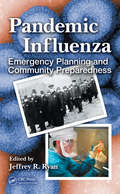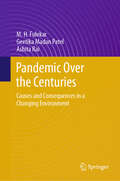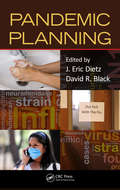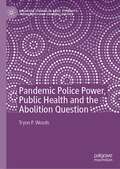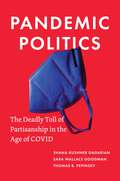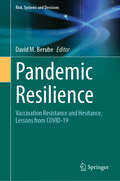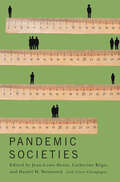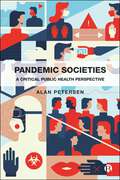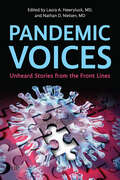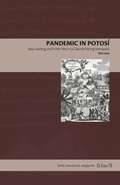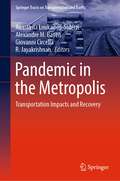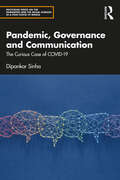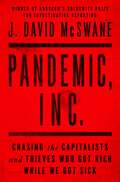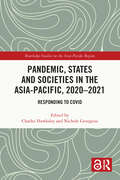- Table View
- List View
Pandemic
by Scott SiglerScott Sigler's Infected shocked readers with a visceral, up-close account of physical metamorphosis and one man's desperate fight for sanity and survival, as "Scary" Perry Dawsey suffered the impact of an alien pathogen's early attempts at mass extinction. In the sequel Contagious, Sigler pulled back the camera and let the reader experience the frantic national response to this growing cataclysm. And now in Pandemic, the entire human race balances on the razor's edge of annihilation, beset by an enemy that turns our own bodies against us, that changes normal people into psychopaths or transforms them into nightmares. To some, Doctor Margaret Montoya is a hero--a brilliant scientist who saved the human race from an alien intelligence determined to exterminate all of humanity. To others, she's a monster--a mass murderer single-handedly responsible for the worst atrocity ever to take place on American soil. All Margaret knows is that she's broken. The blood of a million deaths is on her hands. Guilt and nightmares have turned her into a shut-in, too mired in self-hatred even to salvage her marriage, let alone be the warrior she once was. But she is about to be called into action again. Because before the murderous intelligence was destroyed, it launched one last payload -- a soda can-sized container filled with deadly microorganisms that make humans feed upon their own kind. That harmless-looking container has languished a thousand feet below the surface of Lake Michigan, undisturbed and impotent . . . until now. Part Cthulhu epic, part zombie apocalypse and part blockbuster alien-invasion tale, Pandemic completes the Infected trilogy and sets a new high-water mark in the world of horror fiction.
Pandemic (A\medical Thriller Ser.)
by Robin CookNew York Times-bestselling author Robin Cook takes on the cutting-edge world of gene-modification in this pulse-pounding new medical thriller.When an unidentified, seemingly healthy young woman collapses suddenly on the New York City subway and dies upon reaching the hospital, her case is an eerie reminder for veteran medical examiner Jack Stapleton of the 1918 flu pandemic. Fearful of a repeat on the one hundredth anniversary of the nightmarish contagion, Jack autopsies the woman within hours of her demise and discovers some striking anomalies: first, that she has had a heart transplant, and second, that, against all odds, her DNA matches that of the transplanted heart. Although the facts don't add up to influenza, Jack must race against the clock to identify the woman and determine what kind of virus could wreak such havoc--a task made more urgent when two other victims succumb to a similar rapid death. But nothing makes sense until his investigation leads him into the fascinating realm of CRISPR/CAS9, a gene-editing biotechnology that's captured the imagination of the medical community. . . and the attention of its most unethical members. Drawn into the dark underbelly of the organ transplant market, Jack will come face-to-face with a megalomaniacal businessman willing to risk human lives in order to conquer a lucrative new frontier in medicine--and if Jack's not careful, the next life lost might be his own.
Pandemic 1918: Eyewitness Accounts from the Greatest Medical Holocaust in Modern History
by Catharine ArnoldBefore AIDS or coronavirus, there was the Spanish Flu — Catharine Arnold's gripping narrative, Pandemic 1918, marks the 100th anniversary of an epidemic that altered world history. In January 1918, as World War I raged on, a new and terrifying virus began to spread across the globe. In three successive waves, from 1918 to 1919, influenza killed more than 50 million people. German soldiers termed it Blitzkatarrh, British soldiers referred to it as Flanders Grippe, but world-wide, the pandemic gained the notorious title of “Spanish Flu”. Nowhere on earth escaped: the United States recorded 550,000 deaths (five times its total military fatalities in the war) while European deaths totaled over two million. Amid the war, some governments suppressed news of the outbreak. Even as entire battalions were decimated, with both the Allies and the Germans suffering massive casualties, the details of many servicemen’s deaths were hidden to protect public morale. Meanwhile, civilian families were being struck down in their homes. The City of Philadelphia ran out of gravediggers and coffins, and mass burial trenches had to be excavated with steam shovels. Spanish Flu conjured up the specter of the Black Death of 1348 and the great plague of 1665, while the medical profession, shattered after five terrible years of conflict, lacked the resources to contain and defeat this new enemy. Through primary and archival sources, historian Catharine Arnold gives readers the first truly global account of the terrible epidemic.
Pandemic Cities: The COVID-19 Crisis and Australian Urban Regions (Cities Research Series)
by Elizabeth Taylor John Stone Emma Baker Amanda Davies Scott BaumThis book highlights the impact of the COVID-19 pandemic on cities. The COVID-19 pandemic and the associated economic and social impacts have been felt around the world. In large cities and other urban areas, the pandemic has highlighted a number of issues from pressures on urban labour and housing markets, shifts in demographic processes including migration and mobility, changes in urban travel patterns and pressures on contemporary planning and governance processes. Despite Australia’s relatively mild COVID exposure, Australian cities and large urban areas have not been immune to these issues. The economic shutdown of the country in the early stages of the pandemic, the sporadic border closures between states, the effective closure of international borders and the imposition of widespread public health orders that have required significant behavioural change across the population have all changed our cities in some and the way we live and work in them in some way. Some of the challenges have reflected long-standing problems including intrenched inequality in labour markets and housing markets, others such as the impact on commuting patterns and patterns of migration have emerged largely during the pandemic. This book, co-authored by experts in their field, outlines some of the major issues facing Australian cities and urban areas as a result of the pandemic and sets a course for future of the cities we live in.
Pandemic Communication and Resilience (Risk, Systems and Decisions)
by David M. BerubeThis book examines how we design and deliver health communication messages relating to outbreaks, epidemics, and pandemics. We have experienced major changes to how the public receives and searches for information about health crises over the last twelve decades with the ongoing shift from text/broadcast-based to digital messaging and social media. Both health theories and practices are examined as it applies to testing, tracking, hoarding, therapeutics, and vaccines with case studies. Challenges to communicate about health to diverse audiences (including the science illiterate) and across (both Western and developing economies) have been complicated by politics, norms and mores, personal heuristics, and biases, such as mortality salience, news avoidance, and quarantine fatigue. Issues of economic development and land use, trade and transportation, and even climate change have increased the exposure of human populations to infectious diseases making risk and resilience more pressing. The book has been designed to support health communicators and public health management professionals, students, and interested stakeholders and university libraries.
Pandemic Genres: Imagining Politics in a Time of AIDS
by Neville Wallace HoadA free ebook version of this title is available through Luminos, University of California Press's Open Access publishing program. Visit www.luminosoa.org to learn more. As HIV/AIDS emerged as a public health crisis of significant proportions across sub-Saharan Africa, it became the subject of local and international interest that was at once prurient, benevolent, and interventionist. Meanwhile, the experience of Africans living with HIV/AIDS became an object of aesthetic representation in multiple genres produced by Africans themselves. These cultural representations engaged public discourse—the public policy pronouncements of officials of postcolonial states, an emerging global NGO-speak, and journalism. In Pandemic Genres, Neville Hoad investigates how cultural production—novels, poems, films—around the pandemic supplemented public discourse. He shows that the long historical imaginaries of race, empire, and sex in Botswana, Kenya, and South Africa underwrote all attempts to bring the pandemic into public representation. Attention to genres that stage themselves as imaginary, particularly on the terrain of feeling, may forecast possibilities for new figurations.
Pandemic Influenza
by John Simpson Jonathan Van-Tam Chloe Sellwood John Watson Chris Packham Andy Wapling Angus Nicoll Ab Osterhaus Lim Wei Shen Martyn Regan John Oxford Peter Grove Michaela Hegermann-Lindencrone Lindsey Davies Geert Leroux-Roels Ben Killingley Elaine Gadd Isaac Weisfuse Lance Jennings David Hagen Jim Mcmenamin Joanne Enstone Peter Carasco Arnold Monto Luc Hessel Thomas Szucs Sophia Desillas Richard Pebody Seema Jain Caroline BrownPandemic influenza is a re-emerging pathogen with serious public health consequences. The A(H1N1) pandemic in 2009/10 and the continuing threat to humans from avian influenza A(H5N1) and other novel influenza viruses have both underlined the importance of preparedness at local, national and international levels. With a strong emphasis on practicality, this book offers comprehensive coverage of the science and operational application of influenza epidemiology, virology and immunology, vaccinology, pharmaceutical and public health measures, biomathematical modelling, policy issues and ethics involved in preparing for and responding to pandemic influenza. Each chapter raises key questions and answers them in clear and concise sections, detailing relevant modelling studies and further reading. Comprehensively updated to incorporate major lessons from the 2009/10 pandemic, this second edition includes new contributions on surveillance, International Health Regulations, clinical management and local health service responses, illustrated with vibrant international case studies. Written in an easily accessible style by global experts, this is an essential text for students of public health and those involved in local, national and international pandemic preparedness and response.
Pandemic Influenza: Emergency Planning and Community Preparedness
by Jeffrey R. RyanThe swine flu emergency needn‘t become a crisis. This critically acclaimed work provides public health officials, doctors, responders, and emergency planners with accurate current information that will help them understand the nature of an outbreak, assess risk, answer public concerns, and develop informed strategies. Devoid of sensationalism and a
Pandemic Over the Centuries: Causes and Consequences in a Changing Environment
by M. H. Fulekar Geetika Madan Patel Ashita RaiA pandemic is a global outbreak of new infectious diseases caused by the transmission of emerging and re-emerging pathogens that infect host species. The impact or severity of pandemics is often huge because many individuals lack pre-existing immunity to the new virus. The number of severe cases can increase drastically from endemic levels to that of a pandemic when a large portion of the global population becomes infected. Pandemics can have unusual epidemiological patterns, and large outbreaks may occur under specific conditions based on the nature of the virus. Both manmade and natural disasters can significantly intensify the risk of epidemics; however, pandemics are characterized by exclusive outbreaks with high fatality rates. Throughout history populations all over the world have sporadically faced devastating pandemic outbreaks. It has been observed that, every century, the outbreak of an epidemic caused by a specific virus tends to spread globally as a pandemic. In this context, this book highlights pandemics that have occurred over the centuries. It also examines specific epidemiological patterns and outbreak consequence scenarios across the world. The book aims to enrich the reader's understanding of pandemics by providing valuable insights and knowledge on the preventive measures to be taken in response to pandemic.
Pandemic Pedagogies: Teaching and Learning during the COVID-19 Pandemic (The COVID-19 Pandemic Series)
by J. Michael RyanPandemic Pedagogies: Teaching and Learning during the COVID-19 Pandemic provides critical insights into the impact of the pandemic on the education system, pedagogical approaches, and educational inequalities. Education is often touted as the best way to promote social mobility and produce informed members of society. The pandemic has significantly threatened those goals by temporarily disrupting education and exacerbating disparities in the education system. The scholarship in this volume takes a closer look at many of the issues at the heart of the educational process including teacher self-efficacy, the gendered and racialized impacts of the pandemic on education, school closures, and institutional responses. Drawing on the expertise of scholars from around the world, the work presented here represents a remarkable diversity and quality of impassioned scholarship on the impact of COVID-19 and is a timely and critical advance in knowledge related to the pandemic.
Pandemic Perspectives: Praxis, Policy and Pedagogies
by Reena Marwah Sandra JosephThe book explores the impacts of the COVID-19 pandemic on nations across the globe since early 2020. It hosts a variety of perspectives within economic, social and development research studies, providing contemporary and proper information. The book also presents policy prescriptions for developing economies, critiques the system of disease surveillance and waste management, and defines a vision for India's development. It also mirrors issues related to digitisation, marginalisation, government regulations and health systems and provides original ideas for innovative methodologies suitable for higher education.Print edition not for sale in South Asia (India, Sri Lanka, Nepal, Bangladesh, Pakistan and Bhutan)
Pandemic Planning
by David R. Black J. Eric DietzPreparedness and rigorous planning on community, state, and regional levels are critical to containing the threat of pandemic illness. Steeped in research and recommendations from lessons learned, Pandemic Planning describes the processes necessary for the efficient and effective preparation, prevention, response, and recovery from a pandemic threa
Pandemic Police Power, Public Health and the Abolition Question (Palgrave Studies in Race, Ethnicity, Indigeneity and Criminal Justice)
by Tryon P. WoodsThis book critically explores how police power manifested beyond criminal law into the field of public health during the pandemic. Whilst people were engaged with anti-police violence protests, particularly in the US, they were being policed openly and notoriously by the government and medical science in the public health arena. The book explores how public health policing might be an abuse of constitutional power and encourages the abolition question to be applied consistently to the state’s discourse in the area of public health, as black people the world over continue to bear a disproportionate cost burden for public health policies. The chapters explore contemporary policing in terms of the historical context of slavery, the growth of the police and prison abolition movement and how this should be applied more widely, and how police power operates throughout society beyond the criminal justice system, in finance, technology, housing, education, and in medicine and health science. It seeks to re-examine our relationship to health sovereignty and the police power more fundamentally. It provides insights into the convergence of policing and social control of humans and argues that the most normative response is abolition.
Pandemic Politics: The Deadly Toll of Partisanship in the Age of COVID
by Thomas B. Pepinsky Sara Wallace Goodman Shana Kushner GadarianHow the politicization of the pandemic endangers our lives—and our democracyCOVID-19 has killed more people than any war or public health crisis in American history, but the scale and grim human toll of the pandemic were not inevitable. Pandemic Politics examines how Donald Trump politicized COVID-19, shedding new light on how his administration tied the pandemic to the president’s political fate in an election year and chose partisanship over public health, with disastrous consequences for all of us.Health is not an inherently polarizing issue, but the Trump administration’s partisan response to COVID-19 led ordinary citizens to prioritize what was good for their “team” rather than what was good for their country. Democrats, in turn, viewed the crisis as evidence of Trump’s indifference to public well-being. At a time when solidarity and bipartisan unity were sorely needed, Americans came to see the pandemic in partisan terms, adopting behaviors and attitudes that continue to divide us today. This book draws on a wealth of new data on public opinion to show how pandemic politics has touched all aspects of our lives—from the economy to race and immigration—and puts America’s COVID-19 response in global perspective.An in-depth account of a uniquely American tragedy, Pandemic Politics reveals how the politicization of the COVID-19 pandemic has profound and troubling implications for public health and the future of democracy itself.
Pandemic Resilience: Vaccination Resistance and Hesitance, Lessons from COVID-19 (Risk, Systems and Decisions)
by David M. BerubeThis edited volume draws from health communication scholars and offers a depthful examination of the roles vaccination have played and continue to play in contributing to human, community, and transnational protection against infectious diseases. The problems associated with vaccination against infection diseases was made abundantly clear during the current pandemic of COVID-19. Vaccines were traced back to Dr. Edward Jenner in the 18th century as a tool to control smallpox in England. Today we have six different categories of vaccines (three seem most controversial today): inactivated, live-attenuated, and messenger RNA (mRNA). We examine the reasons for public reluctance and outright resistance to vaccines examining cognitive biases, communication campaign failures, politicization, misinformation, partisanship, and greed. The healthcare industry has not treated all infected people equally, especially the poor and people of color. This is true in the USA as well as abroad. In the future, we can expect more exotic infections to increase due to globalization, development, and transportation. As climate changes, humans will contact more species carrying many different bacteria and viruses. Advances in medical research have led to increases in the number of vaccinations available to control infection and outbreaks. However, the rates of vaccination have fluctuated over time. A vaccine that is not used is meaningless. To increase vaccination rates, we must learn why the public shies away from vaccinations and under what circumstances. This information will enable us to design more effective messaging and communication campaigns to maximize general resilience. An interactive partnership between providers of healthcare and their patients is a prerequisite to productive and effective vaccination campaigns
Pandemic Societies
by Jean-Louis Denis, Catherine Régis, and Daniel WeinstockAt the outset of the COVID-19 pandemic, many thought the changes taking place would be fleeting. It is now widely recognized that COVID-19 will not be the last pandemic in our highly interconnected world, and “pandemic societies” will be with us for some time.Pandemic Societies brings together experts in a wide range of academic disciplines to reflect on how their fields might be transformed in this new context. While the pandemic forces global institutions, such as the World Health Organization, to reimagine the ways in which they function, it also reaches into our everyday lives to change how we organize culture, performing arts, sports, tourism, and cities. Exploring how COVID-19 has altered people’s daily experiences – the ways they meet to play, to perform, and to entertain themselves – this book also pulls the lens back to take in the broader institutional and political contexts in which these quotidian activities are carried out.Examining the profound ways in which the COVID-19 pandemic has transformed every aspect of our lives, Pandemic Societies attempts to understand how we might act to steer this pandemic society, and how to reinvent institutions and practices that we think of as intrinsically face to face.
Pandemic Societies: A Critical Public Health Perspective
by Alan PetersenFrom SARS to Zika, and Ebola to COVID-19, epidemics and pandemics have become increasingly prevalent in recent years. Each outbreak presents new challenges but the responses are often similar. This important book explores the dimensions, dynamics and implications of emerging pandemic societies. Drawing on ideas from sociology and science and technology studies, it sheds new light on how pandemics are socially produced and, in turn, shape societies in areas such as governance, work and recreation, science and technology, education, and family life. It offers pointers to the future of pandemic societies, including the expansion of technologies of surveillance and control, as well as the prospects of social renewal created by economic and social disruption.
Pandemic Voices: Unheard Stories from the Front Lines
by Laura A. Hawryluck Nathan D. NielsenPandemic Voices sheds light on previously unheard or overlooked international perspectives of patients and health care and community services workers through unprecedented access to some of the most challenging moments of the COVID-19 pandemic: the innovations, the stories of lives saved, those of lives lost, and the prices paid. Divided into seven thematic sections, the collection chronicles the experiences from the front lines of the pandemic. It highlights the disruptions faced by medical systems and the innovative adaptations that emerged to simply keep them functioning, as well as the pandemic impacts from locations overlooked by global media. The book delves into the profound effects on health care workers and reveals insights into strain on health care systems. It amplifies the voices of individuals who faced unique struggles during the pandemic, such as caregivers for children with special needs or individuals battling addiction, in times when resources were basically non-existent in a chaotic landscape. The collection concludes with a reflection on how history will judge our pandemic-era actions, alongside the hard lessons learned on truth, science, and advocacy throughout these challenging years. In sharing the heartbreaks, the triumphs, and the scars that left none of us untouched, Pandemic Voices assesses what we have been through – what went well, what did not – in order to learn and, in time, hopefully to heal.
Pandemic in Potosí: Fear, Loathing, and Public Piety in a Colonial Mining Metropolis (Latin American Originals #18)
by Kris LaneIn 1719, a deadly and highly contagious disease took hold of the Imperial Villa of Potosí, a silver mining metropolis in what is now Bolivia. Within a year, the pathogen had killed some 22,000 people, just over a third of the city’s residents. Victims collapsed with fever, body aches, and effusions of blood from the nose and mouth. Most died within days. The great Andean pandemic of 1717–22 was likely the most destructive disease to strike South America since the days of the Spanish conquest.Pandemic in Potosí features the single longest narrative of this nearly forgotten period, penned by local historian Bartolomé Arzáns de Orsúa y Vela, along with shorter treatments of the disease’s ravages in Cuzco, Arequipa, and the outskirts of Lima. The "Gran Peste," as it was called, was a pivotal event about which Arzáns wrote at length because he lived through it, but also because it was believed to have cosmic significance. Kris Lane translates and contextualizes Arzáns’s account, which is rich in local detail that sheds light on a range of topics—from therapeutics, devotional life, class relations, gender, and race to conceptions of illness, sin, and human will and responsibility during a major public health crisis.Original narratives of the pandemic, translated here for the first time, help readers see commonalities and differences between past and present disease encounters. Designed for use in courses on Latin American history, this concise work will also interest scholars and students of the history of religion, history of medicine, urban studies, and epidemiology.
Pandemic in Potosí: Fear, Loathing, and Public Piety in a Colonial Mining Metropolis (Latin American Originals)
by Kris LaneIn 1719, a deadly and highly contagious disease took hold of the Imperial Villa of Potosí, a silver mining metropolis in what is now Bolivia. Within a year, the pathogen had killed some 22,000 people, just over a third of the city’s residents. Victims collapsed with fever, body aches, and effusions of blood from the nose and mouth. Most died within days. The great Andean pandemic of 1717–22 was likely the most destructive disease to strike South America since the days of the Spanish conquest.Pandemic in Potosí features the single longest narrative of this nearly forgotten period, penned by local historian Bartolomé Arzáns de Orsúa y Vela, along with shorter treatments of the disease’s ravages in Cuzco, Arequipa, and the outskirts of Lima. The “Gran Peste,” as it was called, was a pivotal event about which Arzáns wrote at length because he lived through it, but also because it was believed to have cosmic significance. Kris Lane translates and contextualizes Arzáns’s account, which is rich in local detail that sheds light on a range of topics—from therapeutics, devotional life, class relations, gender, and race to conceptions of illness, sin, and human will and responsibility during a major public health crisis.Original narratives of the pandemic, translated here for the first time, help readers see commonalities and differences between past and present disease encounters. Designed for use in courses on Latin American history, this concise work will also interest scholars and students of the history of religion, history of medicine, urban studies, and epidemiology.
Pandemic in the Metropolis: Transportation Impacts and Recovery (Springer Tracts on Transportation and Traffic #20)
by Anastasia Loukaitou-Sideris Alexandre M. Bayen Giovanni Circella R. JayakrishnanThis book brings together reports of original empirical studies which explore the impacts of the COVID-19 pandemic on urban mobility and transportation and the associated policy responses. Focusing on the California region, the book draws on this local experience to formulate general lessons for other regions and metropolitan areas. The book examines how the COVID-19 pandemic has had different impacts on vulnerable populations in cities. It explores the pandemic's impacts on the transportation industry, in particular public transit, but also on other industries and economic interests that rely on transportation, such as freight trucking, retail and food industries, and the gig-economy. It investigates the effect of the viral outbreak on automobile traffic and associated air quality and traffic safety, as well as on alternative forms of work, shopping, and travel which have developed to accommodate the conditions it has forced on society. With quantitative data supported with illustrations and graphs, transportation professionals, policymakers and students can use this book to learn about policies and strategies that may instigate positive change in urban transport in the post-pandemic period.
Pandemic, Governance and Communication: The Curious Case of COVID-19 (Routledge Series on the Humanities and the Social Sciences in a Post-COVID-19 World)
by Dipankar SinhaThis book focuses on what is arguably the most devastating phenomenon in the history of modern civilization, the COVID-19 pandemic. It shows how, on the one hand, the pandemic has exposed governments the world over to deal with a major health crisis; and, on the other, efforts by the ruling forces to enforce surveillance on people and disciplining them by maneuvering cutting-edge digital technology in the name of security and safety. Second, it explores how the mainstream versions of crisis communication and risk communication face huge challenges during a pandemic. Finally, it analyses how the pandemic propels an extraordinary expansion of infodemic — rapid spread of excessive quantities of misinformation and disinformation of the fake and false variety — and how social media in particular becomes its main tool in causing subversion of the prevalent information order. Engaging, comprehensive and accessible, this book will be of immense importance to scholars and researchers of politics, especially governance and political communication, communication studies, and public health management. It will be vital for public policy professionals, experts in thinktanks, career bureaucrats, and non-governmental organizations.
Pandemic, Inc.: Chasing the Capitalists and Thieves Who Got Rich While We Got Sick
by J. David McSwane&“This startling, vital book deserves our attention.&” —San Francisco Chronicle For readers of War Dogs and Bad Blood, an explosive look inside the rush to profit from the COVID-19 pandemic, from the award-winning ProPublica reporter who saw it firsthand. The United States federal government has spent over $10 billion on medical protective wear and emergency supplies, yet as COVID-19 swept the nation, life-saving equipment such as masks, gloves, and ventilators was nearly impossible to find. In this brilliant nonfiction thriller, award-winning investigative reporter J. David McSwane takes us behind the scenes to reveal how traders, contractors, and healthcare companies used one of the darkest moments in American history to fill their pockets. Determined to uncover how this was possible, he spent over a year on private jets and in secret warehouses, traveling from California to Chicago to Washington DC, to interview both the most treacherous of profiteers and the victims of their crimes. Pandemic, Inc. is the story of the fraudster who signed a multi-million-dollar contract with the government to provide lifesaving PPE, and yet never came up with a single mask. The Navy admiral at the helm of the national hunt for additional medical resources. The Department of Health whistleblower who championed masks early on and was silenced by the government and conservative media. And the politician who callously slashed federal emergency funding and gutted the federal PPE stockpile. Winner of the Goldsmith Prize for Investigative Reporting, McSwane connects the dots between backdoor deals and the spoils systems to provide the definitive account of how this pandemic was so catastrophically mishandled. Shocking and revelatory, Pandemic, Inc. exposes a system that is both deeply rigged, and singularly American.
Pandemic, States and Socieites in the Asia-Pacific, 2020-2021: Responding to COVID (Routledge Studies on the Asia-Pacific Region)
by Nichole Georgeou Charles HawksleyHawksley and Georgeou bring together scholars and practitioners from across the region to analyse the main effects of the first two years of the COVID pandemic in a range of case studies from Southeast Asia, East Asia, South Asia, and Oceania. The book provides a broad survey of how Indonesia, Bangladesh, Japan, the Philippines, Vietnam, Nepal, Australia, Cambodia, Taiwan, and New Zealand attempted to manage the COVID pandemic; the challenges they faced; and how they fared. Drawing on insights from politics, economics, sociology, law, public health, education, and geography, most authors are nationals of the cases they discuss. Written in non-specialist language, ten case studies are examined, providing a useful analysis of the first two years of COVID in the Asia-Pacific from the emergence of COVID in January 2020 to the lifting of restrictions in December 2021. Chapters focus on different issues according to the scholar’s academic expertise, and a wide diversity of national pandemic experiences, challenges, and responses are showcased. An essential read for scholars and students interested in the areas of Asia-Pacific politics, sociology, and public health.
Pandemic, States and Societies in the Asia-Pacific, 2020–2021: Responding to COVID (Routledge Studies on the Asia-Pacific Region)
by Nichole Georgeou Charles HawksleyHawksley and Georgeou bring together scholars and practitioners from across the region to analyse the main effects of the first two years of the COVID pandemic in a range of case studies from Southeast Asia, East Asia, South Asia, and Oceania.The book provides a broad survey of how Indonesia, Bangladesh, Japan, the Philippines, Vietnam, Nepal, Australia, Cambodia, Taiwan, and New Zealand attempted to manage the COVID pandemic; the challenges they faced; and how they fared. Drawing on insights from politics, economics, sociology, law, public health, education, and geography, most authors are nationals of the cases they discuss. Written in non-specialist language, ten case studies are examined, providing a useful analysis of the first two years of COVID in the Asia-Pacific from the emergence of COVID in January 2020 to the lifting of restrictions in December 2021. Chapters focus on different issues according to the scholar’s academic expertise, and a wide diversity of national pandemic experiences, challenges, and responses are showcased.An essential read for scholars and students interested in the areas of Asia-Pacific politics, sociology, and public health.Chapter 8 of this book is freely available as a downloadable Open Access PDF at http://www.taylorfrancis.com under a Creative Commons Attribution-Non Commercial-No Derivatives (CC BY-NC-ND) 4.0 license.
